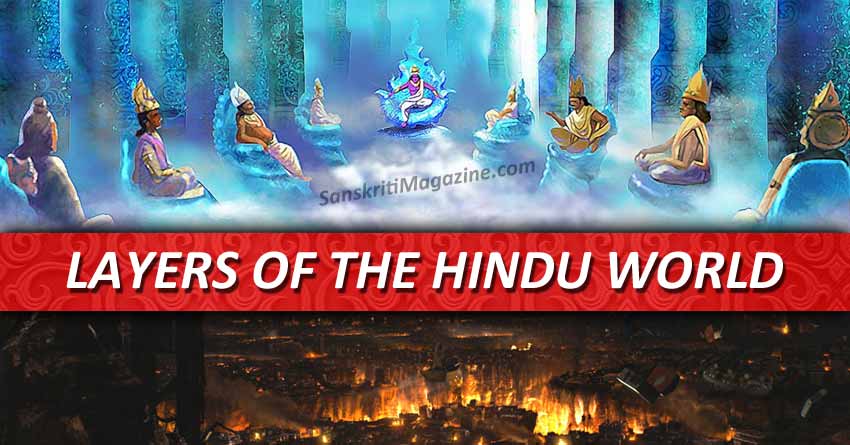The Hindu cosmos or Brahmanda is visualized as a skyscraper. In the centre stands Bhu-lok, earth. Above are realms of increasing happiness, the topmost floor being Dev-lok, where all day people do nothing but enjoy the song and dance of Apsaras, qualifying it to be Swarga, or paradise. Below are realms of decreasing happiness, the lowermost floor being Patal-lok, the realm of Asuras, located below (tala) the feet (pa).
This realm is full of gold and gems, hence the city of Asuras is called Hiranyapura, city of gold. They also hold the secret of renewal and regeneration known as Sanjivani Vidya that helps plants grow. Everyone has to struggle hard to get the plants and metals from beneath the earth, which is necessary for sustenance. Fearful that these treasures will be stolen by the residents of upper realms, the Asuras are in constant guard, never able to rest or sleep or have fun, making their subterranean realm nothing short of Naraka, or hell.
After death, Hindus believe, one goes to the land of the dead, Pitr-lok, separated from the land of the living by the river Vaitarni. Here, depending on the kind of life one has led, Yama, god of death and destiny, determines the Lok where one will be reborn. Good deeds grants entry into the upper happy realms, even Dev-lok if one has been really very good. Bad deeds, however, leads one to lower unhappy realms, perhaps even Patal-lok.
It must be clarified that Dev-lok is not Heaven, a concept that comes from Christian and Islamic traditions. The notion of rebirth does not exist in Christianity or Islam: one has only one life, and hence only one opportunity to gain entry into Heaven. That is why Christians and Muslims believe only in one Heaven (spelt in capital and singular) while Hindus entertain the ideas of multiple heavens with different grades of happiness. There are even multiple hells.
Since Hindus believe in rebirth, there are ample opportunities to enter Dev-lok, but the stay there is temporary, limited by the balance of equity of past deeds in one’s karmic account. When this runs out, one is out of Dev-lok. The good news is, stay in Patal-lok is also temporary. By doing good deeds, one can move up to a higher realm of more happiness and lesser work. Thus a Deva can become an Asura and an Asura can become a Deva.
Naturally, Asuras crave access to Dev-lok while Devas do everything in their power to stay there eternally. Hence the intense yearning of the Devas for the elusive Amrita, nectar of eternal youth and immortality. But while this nectar grants Devas youth and immortality, it does not grant them contentment. There is always the threat of an Asura attack, making Devas eternally insecure and restless, preventing them from enjoying the pleasures of paradise.
This elaborate geography clearly is trying to communicate a profound truth. The residents of Dev-lok have fun. The residents of Patal-lok have wealth. But neither is content. Because neither fun nor wealth is ever enough; one always craves more.
That is why the Hindu world offers yet another destination, one that exists higher than Dev-lok, where there is no craving, only contentment. Vishnu-worshippers call this realm Vishnu-lok while Shiva-worshippers call it Shiva-lok. Unlike Dev-lok which is merely paradise, Vishnu-lok and Shiva-lok are heavens. And to reach it, one has to go beyond the practice of accumulating good or bad karmas. One has to step back and appreciate life for what it is, without prejudice, not getting upset by the problems and not getting exhilarated by the solutions. This is moksha – blissful repose born of wisdom and love.
At another level, the concept of Lok can be seen as the addressing of the issue of aura or personal zones that people create around them. It depends on their personality and their attitude. The Lok of some people are inviting and inclusive – we seek the company of such people. The Lok of others is repulsive – we avoid the company of such people. Thus the whole world is full of innumerable creatures, each creating Lok. The scriptures suggest that working on our attitude, we can change the nature of the Lok around us – we can create Asur-lok, where we discuss only about possessing things; we can create Dev-lok, where all that matters is fun; or we can create Shiv-lok, where peace and contentment reigns supreme.










